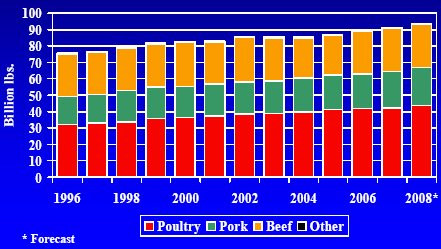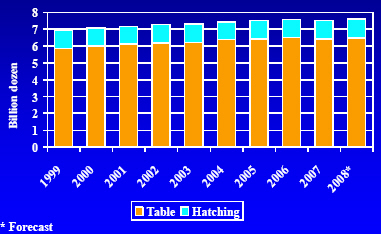



Challenging Year for Livestock Production
The livestock and poultry industry in the US will be increasingly challenged this year by rising feed prices that drive up costs and lower returns, and by consumers confronted with uncertain economic conditions.Speaking at the US Agricultural Outlook Forum earlier this year Joel Greene, the livestock analyst with the World Agricultural Outlook Board of the USDA, said that there will be a record 93 billion pounds of red meat and poultry to move through domestic and international channels this year.
He said that the country's economic growth was at its weakest during the first half of the year and is expected to fall by between one and two per cent over the year.
He said he expected to see a change in consumer patterns as the weaker economy produced reduced confidence. This could see US consumers eat out less and turn to cheaper cuts of meat.
While the slowing in economic growth is expected around the world Mr Greene said that internationally it is expected to be about three per cent.
"US red meat and poultry exports will continue to be supported by a weak US dollar, and are expected to top 12 billion pounds this year," Mr Greene told the forum.
"Returns for livestock and poultry producers will fall during the year, and as a result production growth for all red meat and poultry slows later in the year."
He said that as carcase weights have increased in recent years, but this year the rise in weights is not expected to be as great as pig and poultry producers in particular strive to reduce feed costs.
Cattle producers are expected to leave cattle on grass longer if pasture conditions permit in order to offset some of the increased feed costs.
Mr Greene said that prices for cattle, hogs, and poultry in 2008 are expected to decline, but retail prices for beef and pork are expected to rise, although broiler and turkey prices could be slightly lower.

Broiler Production to Increase
Broiler production is forecast to increase about three per cent to nearly 37 billion pounds in 2008. This is on top of an increase of less than one per cent last year, when it reached 35.9 billion pounds. The slight increase follows the gradual decline that had been seen at the end of 2006. But in the middle of last year prices reached record highs, forcing up production again.
"The number of chicks placed each week for growout has averaged three to five per cent above year earlier since last fall, compared with about a one per cent increase for the earlier part of the year," Mr Greene said.
"By mid-2007 growth in the broiler laying flock turned strongly positive after lagging through 2006 and into 2007. Broiler production growth is expected to be stronger during the first half of the year, and then slow considerably by the fourth quarter because of higher feed costs and weaker prices," he said.
Stocks of broiler meat during the year are also expected to be higher in 2008 than in 2007 but start to decline by the last quarter.
US broiler meat exports are expected to rise by two per cent to a record 5.9 billion pounds this year.
In 2007, broiler exports reached nearly 5.8 billion pounds, overtaking the previous record of 5.6 billion set in 2001.
"Over several years prior to 2007 broiler export growth was sluggish because of an uncertain import regime in Russia, including a quota that was eventually converted to a tariff-rate quota, restrictions on border trade with countries surrounding Russia that were often entry points for US broiler meat, and then, of course, outbreaks of highly pathogenic Avian Influenza that dampened demand for broiler meat for short periods in markets across the globe, but especially Eastern European and Asian markets," he said.
"Last year exports took off again even though US broiler parts prices, particularly leg quarters, reached record highs mid-year. Firm world economic growth, a weak US dollar, and in many markets, strong growth in oil income, provided the impetus to send broiler exports higher in 2007."
Last year, exports to Canada, China, and Cuba reached record levels. US broiler shipments to Russia were 1.9 billion pounds, the highest since 2001.
This year, the United States is allocated nearly 2.0 billion pounds of total poultry under the Russia quota regime.
"Broiler exports to China benefited from the outbreak of blue ear disease in Chinese hogs that drove pork prices up and shifted consumption towards broilers," Mr Greene said.

Turkey Production Growth Slowing
Turkey production in 2008 is forecast to increase more than 2.5 per cent to almost 6.1 billion pounds. However, Mr Greene said that this growth is below the three to four per cent rise in production seen in the previous two years. Higher feed costs for turkey producers will temper growth in turkey weights. In 2007, turkey production increased more than four per cent to a record 5.9 billion pounds because of a 3.5 per cent increase in the number of turkeys slaughtered, he said.
Alongside this, dressed weights only rose by about one per cent.
"Weight gains are again expected to be modest this year because of higher feed costs and higher turkey slaughter will account for most of the production increase," he said.
Although the latest turkey hatchery data showed a slowing of poult placements in January, eggs in incubators on 1 February were four per cent higher than a year earlier, indicating increases in turkey production later this year.
However, Mr Greene said that the higher feed prices will continue to limit weight gains and will put pressure on producer returns.
Turkey exports rose by about one per cent last year to 554 million pounds and this year they are expected to rise by nine per cent to 605 million pounds.
The largest market for US turkey is Mexico, but here exports were slightly lower than in previous years. The record shipments to China and a strong increase to Russia more than offset the weaker Mexican market.

Egg Production Expected to Rise
Total US egg production for 2008 is expected to rise slightly more than one per cent. Egg production fell by 0.7 per cent in 2007 the first annual decline since 1989.
Hatching egg production, which accounts for about 15 per cent of total egg production in the US, rose by nearly three per cent last year and is expected to increase by a further two per cent this year.
Table egg production declined 1.3 per cent in 2007, but is expected to increase 1.2 per cent. Despite record egg prices, table egg producers have been slow to boost production.
Throughout 2007 the number of table layer hens was below a year earlier, and the number of layers remained below that of a year ago to start this year.
"With egg production forecast to gradually rise during the year, egg prices are expected to decline but remain relatively strong, " Mr Greene said.
Egg and egg product exports reached 251 million dozen, shell egg equivalent, the highest since 1996, with shipments to the EU-27 more than doubling last year.
Exports are forecast to fall to 230 million dozen as high prices slow demand.

Further Reading
| - | You can read Joel Greene's full report by clicking here. |
April 2008








